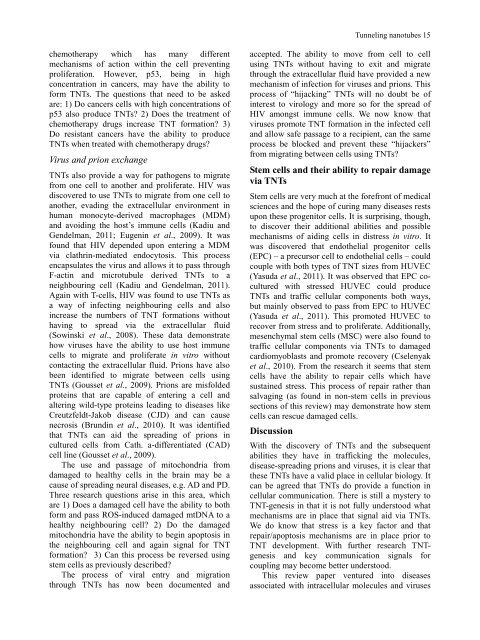Journal of Cell and Molecular Biology - ResearchGate
Journal of Cell and Molecular Biology - ResearchGate
Journal of Cell and Molecular Biology - ResearchGate
Create successful ePaper yourself
Turn your PDF publications into a flip-book with our unique Google optimized e-Paper software.
chemotherapy which has many different<br />
mechanisms <strong>of</strong> action within the cell preventing<br />
proliferation. However, p53, being in high<br />
concentration in cancers, may have the ability to<br />
form TNTs. The questions that need to be asked<br />
are: 1) Do cancers cells with high concentrations <strong>of</strong><br />
p53 also produce TNTs? 2) Does the treatment <strong>of</strong><br />
chemotherapy drugs increase TNT formation? 3)<br />
Do resistant cancers have the ability to produce<br />
TNTs when treated with chemotherapy drugs?<br />
Virus <strong>and</strong> prion exchange<br />
TNTs also provide a way for pathogens to migrate<br />
from one cell to another <strong>and</strong> proliferate. HIV was<br />
discovered to use TNTs to migrate from one cell to<br />
another, evading the extracellular environment in<br />
human monocyte-derived macrophages (MDM)<br />
<strong>and</strong> avoiding the host’s immune cells (Kadiu <strong>and</strong><br />
Gendelman, 2011; Eugenin et al., 2009). It was<br />
found that HIV depended upon entering a MDM<br />
via clathrin-mediated endocytosis. This process<br />
encapsulates the virus <strong>and</strong> allows it to pass through<br />
F-actin <strong>and</strong> microtubule derived TNTs to a<br />
neighbouring cell (Kadiu <strong>and</strong> Gendelman, 2011).<br />
Again with T-cells, HIV was found to use TNTs as<br />
a way <strong>of</strong> infecting neighbouring cells <strong>and</strong> also<br />
increase the numbers <strong>of</strong> TNT formations without<br />
having to spread via the extracellular fluid<br />
(Sowinski et al., 2008). These data demonstrate<br />
how viruses have the ability to use host immune<br />
cells to migrate <strong>and</strong> proliferate in vitro without<br />
contacting the extracellular fluid. Prions have also<br />
been identified to migrate between cells using<br />
TNTs (Gousset et al., 2009). Prions are misfolded<br />
proteins that are capable <strong>of</strong> entering a cell <strong>and</strong><br />
altering wild-type proteins leading to diseases like<br />
Creutzfeldt-Jakob disease (CJD) <strong>and</strong> can cause<br />
necrosis (Brundin et al., 2010). It was identified<br />
that TNTs can aid the spreading <strong>of</strong> prions in<br />
cultured cells from Cath. a-differentiated (CAD)<br />
cell line (Gousset et al., 2009).<br />
The use <strong>and</strong> passage <strong>of</strong> mitochondria from<br />
damaged to healthy cells in the brain may be a<br />
cause <strong>of</strong> spreading neural diseases, e.g. AD <strong>and</strong> PD.<br />
Three research questions arise in this area, which<br />
are 1) Does a damaged cell have the ability to both<br />
form <strong>and</strong> pass ROS-induced damaged mtDNA to a<br />
healthy neighbouring cell? 2) Do the damaged<br />
mitochondria have the ability to begin apoptosis in<br />
the neighbouring cell <strong>and</strong> again signal for TNT<br />
formation? 3) Can this process be reversed using<br />
stem cells as previously described?<br />
The process <strong>of</strong> viral entry <strong>and</strong> migration<br />
through TNTs has now been documented <strong>and</strong><br />
<br />
Tunneling nanotubes 15<br />
accepted. The ability to move from cell to cell<br />
using TNTs without having to exit <strong>and</strong> migrate<br />
through the extracellular fluid have provided a new<br />
mechanism <strong>of</strong> infection for viruses <strong>and</strong> prions. This<br />
process <strong>of</strong> “hijacking” TNTs will no doubt be <strong>of</strong><br />
interest to virology <strong>and</strong> more so for the spread <strong>of</strong><br />
HIV amongst immune cells. We now know that<br />
viruses promote TNT formation in the infected cell<br />
<strong>and</strong> allow safe passage to a recipient, can the same<br />
process be blocked <strong>and</strong> prevent these “hijackers”<br />
from migrating between cells using TNTs?<br />
Stem cells <strong>and</strong> their ability to repair damage<br />
via TNTs<br />
Stem cells are very much at the forefront <strong>of</strong> medical<br />
sciences <strong>and</strong> the hope <strong>of</strong> curing many diseases rests<br />
upon these progenitor cells. It is surprising, though,<br />
to discover their additional abilities <strong>and</strong> possible<br />
mechanisms <strong>of</strong> aiding cells in distress in vitro. It<br />
was discovered that endothelial progenitor cells<br />
(EPC) – a precursor cell to endothelial cells – could<br />
couple with both types <strong>of</strong> TNT sizes from HUVEC<br />
(Yasuda et al., 2011). It was observed that EPC cocultured<br />
with stressed HUVEC could produce<br />
TNTs <strong>and</strong> traffic cellular components both ways,<br />
but mainly observed to pass from EPC to HUVEC<br />
(Yasuda et al., 2011). This promoted HUVEC to<br />
recover from stress <strong>and</strong> to proliferate. Additionally,<br />
mesenchymal stem cells (MSC) were also found to<br />
traffic cellular components via TNTs to damaged<br />
cardiomyoblasts <strong>and</strong> promote recovery (Cselenyak<br />
et al., 2010). From the research it seems that stem<br />
cells have the ability to repair cells which have<br />
sustained stress. This process <strong>of</strong> repair rather than<br />
salvaging (as found in non-stem cells in previous<br />
sections <strong>of</strong> this review) may demonstrate how stem<br />
cells can rescue damaged cells.<br />
Discussion<br />
With the discovery <strong>of</strong> TNTs <strong>and</strong> the subsequent<br />
abilities they have in trafficking the molecules,<br />
disease-spreading prions <strong>and</strong> viruses, it is clear that<br />
these TNTs have a valid place in cellular biology. It<br />
can be agreed that TNTs do provide a function in<br />
cellular communication. There is still a mystery to<br />
TNT-genesis in that it is not fully understood what<br />
mechanisms are in place that signal aid via TNTs.<br />
We do know that stress is a key factor <strong>and</strong> that<br />
repair/apoptosis mechanisms are in place prior to<br />
TNT development. With further research TNTgenesis<br />
<strong>and</strong> key communication signals for<br />
coupling may become better understood.<br />
This review paper ventured into diseases<br />
associated with intracellular molecules <strong>and</strong> viruses

















